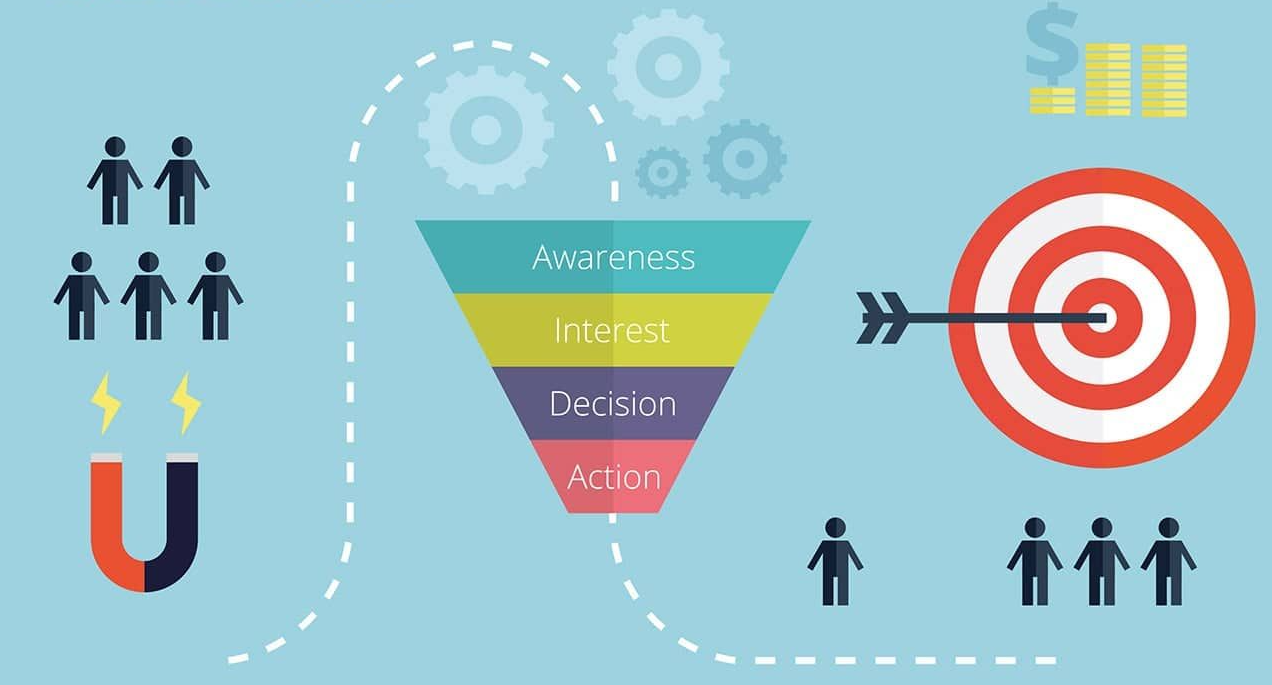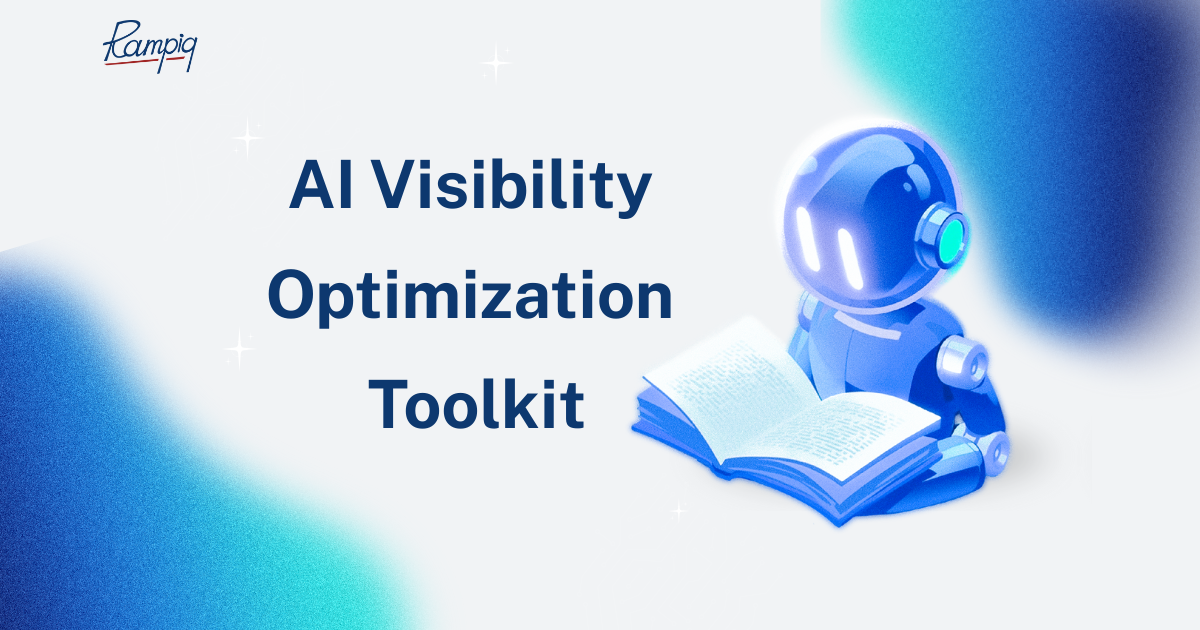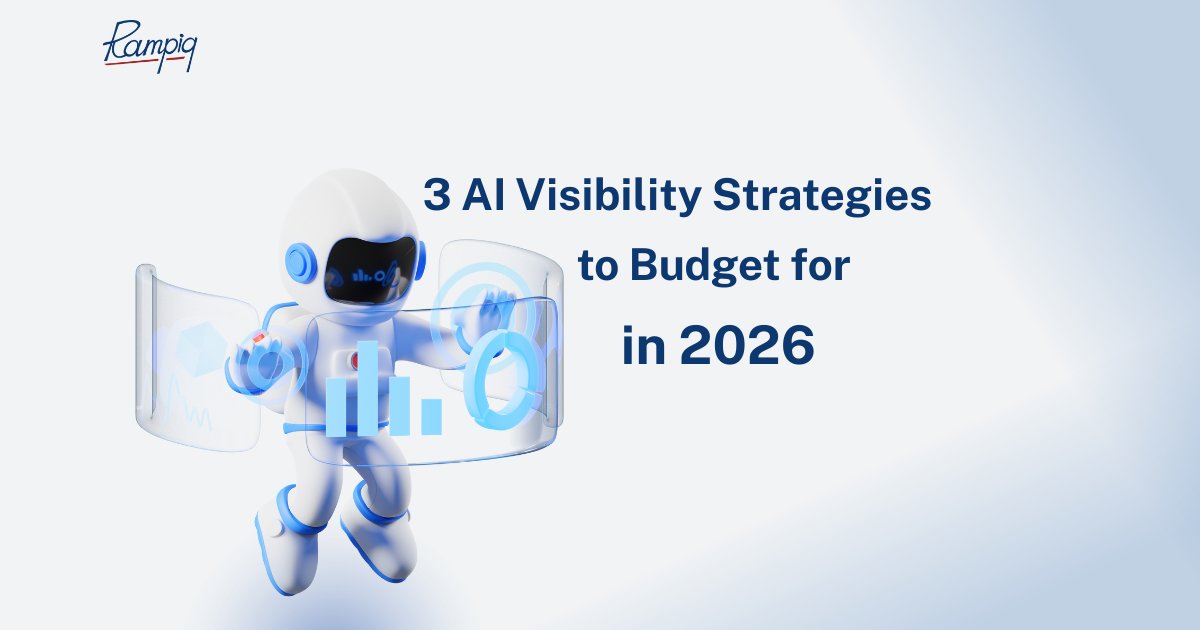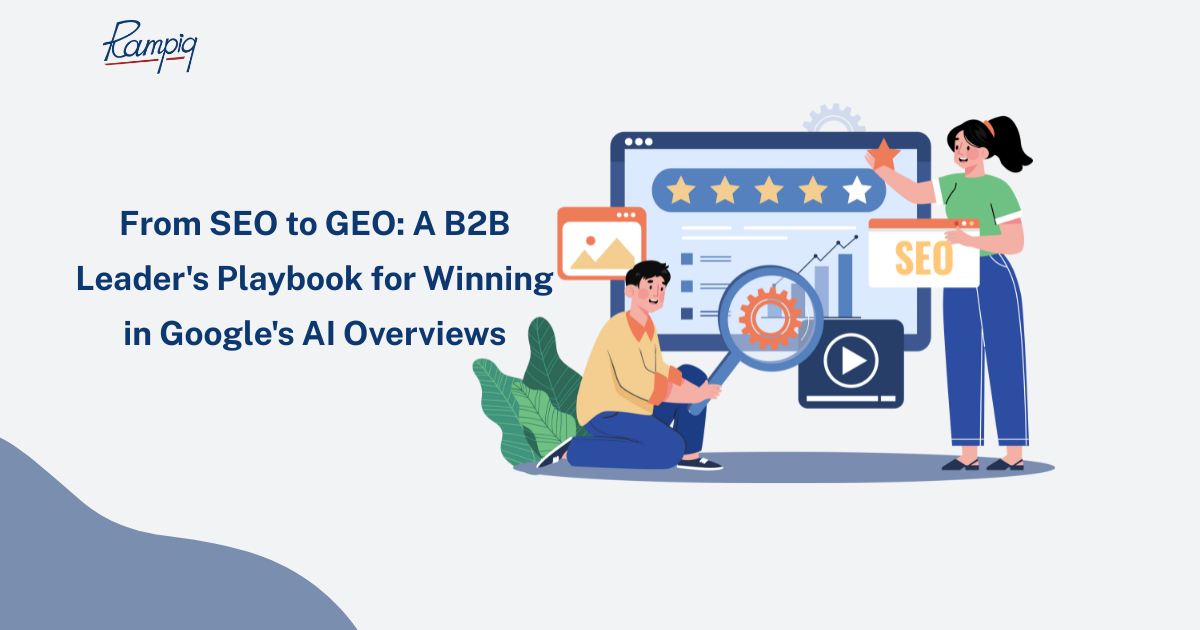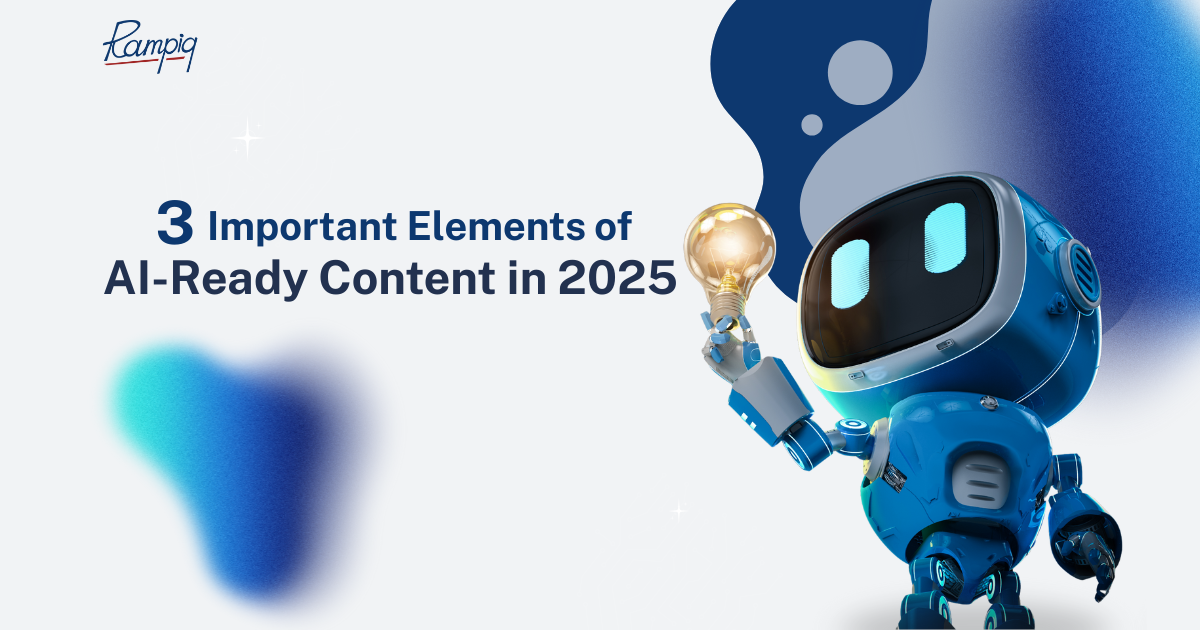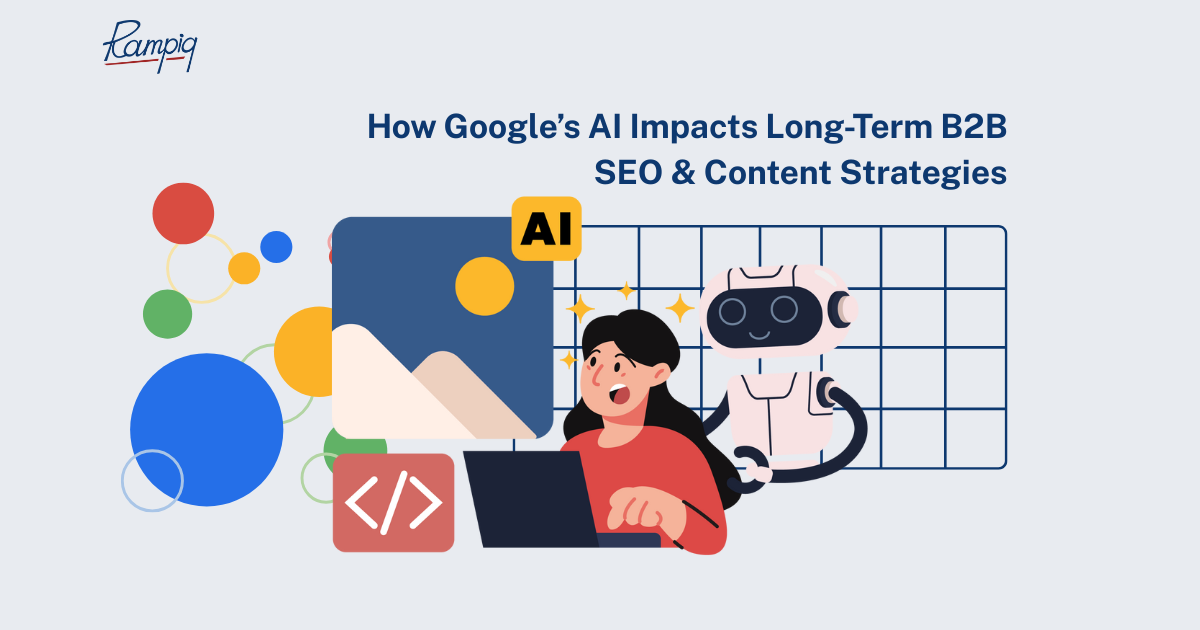Understanding the Traditional Sales Funnel
The traditional sales funnel is a structured representation of a prospect’s journey from initial awareness to the final purchase decision, delineating the critical phases of top (awareness), middle (evaluation), and bottom (decision).
This analytical tool empowers sales teams by illuminating the pathway through which prospects become customers, highlighting the pivotal moments for engagement and strategy adjustment to enhance lead conversion and sales success.
Imagine the sales funnel as the path your potential customers tread, beginning with their first encounter with your brand and culminating in a completed transaction. It’s a vital tool for your sales force, providing clarity on when to intensify follow-ups or adjust tactics to prevent leads from slipping away.
Fundamentally linked to the customer’s purchasing journey, the sales funnel can be dissected into three critical sections: the top (awareness stage), the middle (consideration stage), and the bottom (decision stage). This structure elucidates the progression of prospects through key phases: from being Untouched, to Contact made (Leads), Qualified, Proposal presented, Negotiation, and finally, to Won.
B2B SaaS Sales Funnels vs. Traditional Sales and Marketing Funnels
Traditional sales and marketing funnels focus on first making prospects aware of your product, getting them to consider it, and then converting them into paying customers. The key differences between that and the SaaS sales funnel are centered on data. Unlike the traditional funnels, here, we don’t assume that users move linearly.
Common traditional models like AIDA (Attention, Interest, Desire, Action) designed for sales and marketing assume that the customer always moves in a linear path.
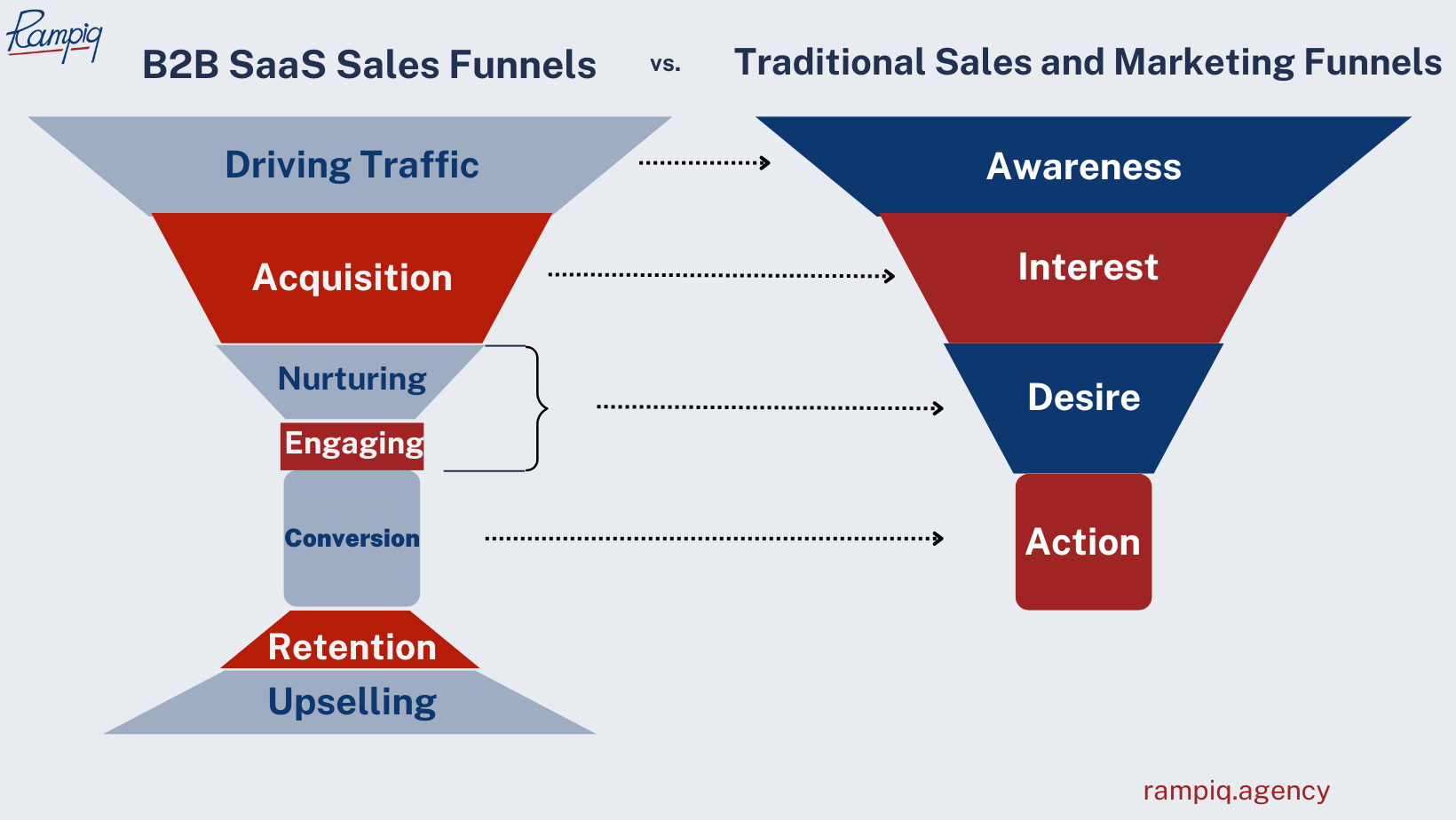
If that was the case, then attracting the attention of a prospect and building brand product awareness should spark interest in your product. You then heat this interest to convert it into your desired end-action.
However, new studies, such as that of Emerald Insight and Havard Business Review show that it’s not as simple as the traditional models assume. Although this is just a theoretical model that gives an overview of the sales process, we now have data for more thorough analyses. Hence, there’s no good reason to utilize the traditional models as it affects efficiency.
Since businesses now have so much data on their prospects, they can tell what emails they viewed, the links they followed, their scroll depth, etc., as well as data from their actual use of the product or demo.
What happens here is that the data can move in the reverse direction also, and businesses use it to continuously optimize their funnels.
The Problems With Traditional Sales and Marketing Funnels
The traditional marketing and sales funnel is not a bad model, as it’s still excellent for simple, tangible products. The linear funnel is sufficient for companies selling fashion or electronics, for example.
However, when it comes to subscription-based products, innovative products, and similar intangible products, that is where the linear approach of traditional sales and marketing funnels can be found lacking. It fails to account for the complexities of B2B SaaS products and the longer sales cycles involved.
Let’s go more in-depth and discuss the various areas in which the traditional funnels fall short compared to what modern B2B SaaS businesses use today. The table below summarizes the problems with traditional sales and marketing funnels, and how the modern B2B SaaS pipeline solves them.
|
Traditional Sales and Marketing Funnels |
Modern B2B SaaS Sales Funnels |
| Linear Approach |
Follows a linear path from acquisition to conversion |
Does not assume linear progression, focuses on personalized experiences and relationship building |
| Personalization |
Provides a generic, one-size-fits-all experience |
Tailors products, messaging, offers, and experiences to individual prospects |
| Education |
Does not prioritize the education of prospects |
Incorporates educational elements to help prospects understand the value of the solution |
| Engagement Opportunities |
Limited opportunities for engagement with prospects |
Provides personalized interactions, demonstrations, and ongoing communication to nurture relationships |
| Conversion Goals |
Primarily focused on converting prospects into paying customers |
Includes onboarding, customer retention, and upselling to increase recurring revenue |
| Data-driven Optimization |
Limited use of data for funnel optimization |
Leverages prospect data to continuously optimize the funnel |
| Emphasis on Customer Success |
Less emphasis on customer success and retention |
Prioritizes customer success and retention for long-term value
|
Without further ado, let’s delve into these:
Lack of Personalization
Traditional funnels treat all prospects the same, almost like providing a generic, one-size-fits-all experience. It overlooks the importance of tailoring your products, messaging, offers, and experiences to individual prospects.
However, in today’s B2B SaaS industry, personalization is crucial for connecting with potential customers and effectively addressing their pain points. It’s also vital for building trust and brand loyalty.
To overcome this problem, modern B2B SaaS marketers employ various personalization tactics to create tailored experiences for individual prospects.
Here are some examples of modern personalization tactics:
1. Dynamic Content:
Modern B2B SaaS sales funnels deliver personalized content based on a prospect’s interests, behavior, or demographic by leveraging marketing automation tools. The personalization here includes customized landing pages, email campaigns, or website user experiences that resonate with each of them on a personal level.
2. Account-Based Marketing (ABM):
ABM lets you focus your marketing efforts on specific high-value accounts. You tailor your messages, content, and offers to the unique needs and pain points of these accounts to create a more targeted approach that engages key decision-makers.
3. Retargeting Ads:
Leveraging website tracking and retargeting ads allows a business to deliver personalized offers to prospects who have shown interest in your product or visited specific pages on your website. Doing this increases their likelihood of conversion.
An Inability to Educate Prospects
Another major issue with traditional sales and marketing funnels is their inability to effectively educate prospects, especially when it comes to B2B SaaS products. These products often need a significant level of education before prospects fully understand their value. But traditional funnels tend to not prioritize education, leaving potential customers without the necessary data to make informed decisions.
In contrast, modern B2B SaaS marketing funnels incorporate educational elements at various stages of the customer journey. This ensures that prospects are well-informed and equipped to evaluate the solution effectively.
Here are some tactics that progressive SaaS businesses use to educate prospects:
1. Content Marketing:
Publishing informative blog posts, whitepapers, case studies, and videos that address the challenges and pain points of your target B2B audience is a powerful strategy. These resources should provide valuable insights, educational content, and best practices related to your product or industry.
2. Webinars and Online Events:
What better way to showcase your product and establish your brand than for them to hear it from the proverbial horse’s mouth? You can do this via educational webinars or virtual events. These events provide a platform for interactive discussions, Q&A sessions, and demos, all of which enable a deeper understanding of your offer and its value.
3. Knowledge Base and FAQ:
Developing a comprehensive knowledge base and frequently asked questions (FAQ) section on your website is essential for educating prospects. This resource should provide detailed explanations of your product’s features and benefits, as well as answers to common questions. It allows prospects to find the information they need to make informed decisions.
4. Free Trials and Demos:
Offering free trials or product demonstrations allows prospects to experience your solution firsthand and understand its value. You want your product to help a business process, fulfill a need, or replace an existing product they use, etc. Other strategies for helping them navigate and understand the product’s features more effectively include providing guided tours, tutorials, and documentation.
Limited Engagement Opportunities
Engagement plays a crucial role in B2B SaaS marketing, as prospects need time to evaluate the solution and trust the brand before committing to a purchase. Unfortunately, traditional sales and marketing funnels often fall short of providing ample opportunities for engagement with prospects, leading to missed chances to nurture relationships and address specific concerns.
To overcome this limitation, successful B2B SaaS marketers employ various engagement techniques throughout the sales and marketing funnels. These techniques allow for personalized interactions, product demonstrations, and ongoing communication to keep prospects engaged at every stage of the process.
Here are some Typical engagement techniques used in modern B2B SaaS marketing funnels:
1. Live Chat and Chatbots:
Implementing live chat functionality on your website enables real-time assistance and the opportunity to answer prospects’ questions promptly, establish a personal connection, and provide immediate support, enhancing the overall engagement experience. Apart from offering initial assistance, they also help with gathering information to further personalize their experience as discussed in the first point in this section.
2. Interactive Content:
B2B SaaS businesses may also create interactive content, such as quizzes, assessments, or interactive calculators. The use of these is to provide an engaging experience for prospects. These interactive tools not only capture their attention but also allow them to actively participate and receive customized results. It fosters a sense of involvement and helps prospects better understand how your solution can address their specific needs.
3. Personalized Product Demonstrations:
Apart from educating prospects about your products as discussed earlier, offering demos tailored to the prospects’ specific requirements and pain points can be highly effective in driving engagement. For this, you want to showcase how your solution solves their challenges and meets their unique needs. Employing this tactic allows your business to create a compelling case for your product and increase prospects’ interest and involvement.
4. Ongoing Communication:
This can include sending personalized emails, newsletters, or targeted content based on the prospects’ interests and preferences. By staying in touch and providing valuable information, you keep prospects engaged and build stronger relationships over time.
5. Customer Success Stories and Case Studies:
Sharing success stories and case studies of satisfied customers can be a powerful engagement tactic. Prospects will relate to these real-life examples and envision how your solution can bring similar benefits to their own business.
Modern B2B SaaS Sales Funnel Stages
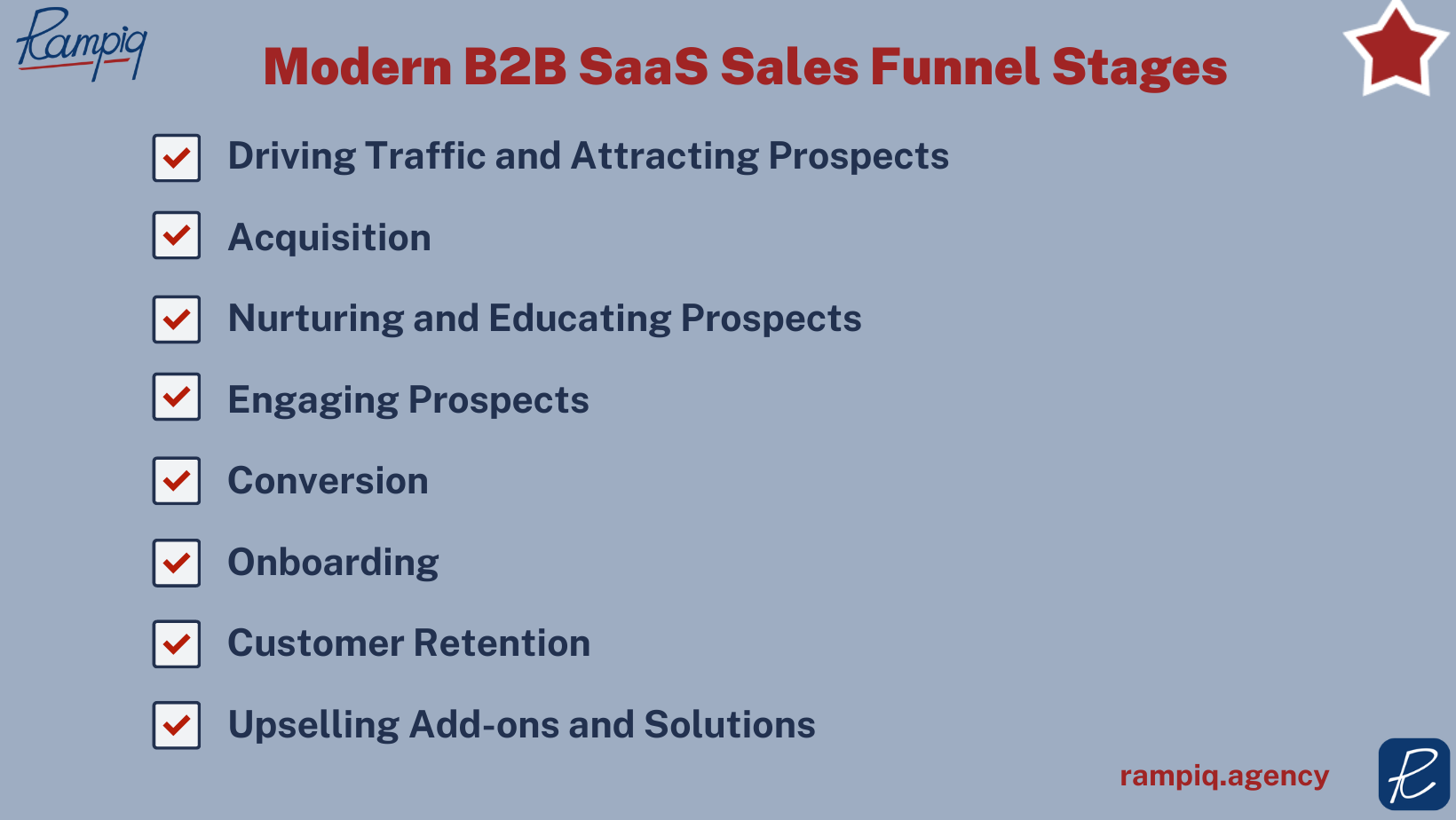
To address the shortcomings of traditional funnels, B2B SaaS companies have developed modern sales funnel for SaaS with stages tailored to the industry’s needs. Let’s explore the B2B SaaS sales funnel stages in more detail.
1. Driving Traffic and Attracting Prospects
Driving targeted traffic to your website is the initial stage of a B2B SaaS sales funnel. Using demand capture channels, such as search engine optimization (SEO), content marketing, and paid advertising, can effectively attract prospects who are actively seeking solutions like yours.
2. Acquisition
The next item in the SaaS sales funnel stages is customer acquisition. Once prospects land on your website, you want to capture their attention and convert them into leads and users. Companies do this by aligning their messaging and positioning with the pain points of their prospects.
Doing this ensures that they’re offering clear value propositions that resonate with their needs, and emphasizing how your B2B SaaS solution solves their specific challenges and provides tangible benefits.
When you capture new users, the next objectives are to retain them and convert them into subscribers for as long as possible. That leads us to the next stage.
3. Nurturing and Educating Prospects
This SaaS sales funnel stage is also all about delivering targeted content that educates prospects about your product and its unique features. This is where businesses develop a comprehensive content strategy that includes blog posts, whitepapers, emails, case studies, webinars, and educational videos. While these resources address common pain points and showcase the benefits of your solution, you will also build trust and credibility and guide prospects toward a deeper understanding of your offering. Note that the more personalized and relevant your content is, the less likely for users to churn.
4. Engaging Prospects
As prospects progress through the B2B SaaS sales funnel, the company now has to maintain communication with them. This is most effective with personalized interactions where you continue to address their concerns and needs. A lot of automation and further personalization can be implemented especially in this stage.
It’s common now for companies to offer demos modified to the prospects’ industry or user case so that they can experience the value and functionality firsthand. Other vital tools to leverage to maintain ongoing engagement and foster a sense of connection with prospects are personalized email campaigns, live chat support, and social media interactions.
5. Conversion
The conversion stage focuses on persuading prospects to subscribe to your product. Lead nurturing strategies such as personalized email drips come into play here as you want to maintain communication and guide prospects toward making a purchase decision.
This is the point where you emphasize the unique value proposition of your offering and provide compelling incentives to encourage conversion. Now, you’re almost sure that the users in this segment are interested in your product and may only need a little more push and convincing. Popular tactics product companies use here include offering limited-time discounts, exclusive features, or extended trial periods.
These create a sense of urgency and demonstrate the value of your solution. Regarding demonstrating the value, it’s crucial that your communication showcases use cases and relevant real-world problems your product solves.
6. The Onboarding Process
Once prospects become subscribers, the onboarding process should be a smooth transition and deliver a positive user experience. If you want this, you will have to provide clear instructions, tutorials, and training materials to help new subscribers get started with your solution quickly.
Implement customer success strategies, such as regular check-ins, to address their questions or concerns and ensure that subscribers are maximizing the benefits of your B2B SaaS solution from the start.
7. Customer Retention
Customer retention is a key focus in the B2B SaaS industry, as it is more cost-effective to retain existing customers than acquire new ones. Implement customer success programs to proactively support your subscribers, offer ongoing training and resources, and provide excellent customer service. Regularly communicate updates, product enhancements, and relevant industry insights to keep subscribers engaged and demonstrate the continuous value of your solution.
8. Upselling Add-ons and Solutions
As your relationship with subscribers strengthens, opportunities to upsell additional add-ons or solutions that enhance their experience or address additional pain points will present themselves.
Suggest your add-on solutions or services that make them use the main product better. The best ways to reach the users are through personalized recommendations based on their usage patterns or by identifying specific needs through customer surveys or feedback.
It’s also excellent to offer dedicated support for implementing and integrating these add-ons or solutions, ensuring a smooth transition and maximizing the value for your subscribers.
